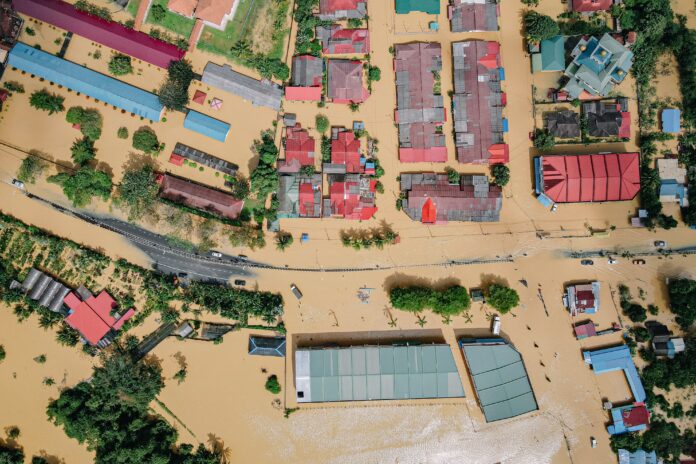
By
Warm spring temperatures bring melting snow and rain. But in the Quad Cities, a collection of five small cities bordering the Mississippi River in southeastern Iowa and northwestern Illinois, residents have once again been hard-hit by catastrophic flooding.
Caught in this deluge of water is Davenport, Iowa, an 11% Black, 15% low-income city of 100,000 residents on the western bank of the Mississippi.
Alicia Houston, a Black resident who moved to Davenport a year ago, says flooding in the predominantly Black and low-income west end of the city’s downtown has been largely ignored.
Historic flooding affected the area in 1965, 1993, 2008, 2014, 2019, and now again this year. On April 23, snowmelt from Wisconsin and Illinois made its way to Davenport. The river reached major flood stage and officially crested in the city at 21.51 feet on Monday, May 1.
Houston says on April 29, her home was completely surrounded by water, and it didn’t recede for two weeks. She says FEMA never contacted her.
“FEMA knows we are in trouble,” Houston says. “Where’s FEMA? We need help. I haven’t heard anything from FEMA.”
But flood-related problems for the Black community aren’t just in Iowa. An E & E News analysis of federal flood insurance payments found that Black people nationwide are more likely to be affected by flooding than other groups. In addition, due to the racial wealth gap, Black people are potentially less likely to be able to recover financially from flooding.
“A lot of times, we rent. We don’t have the money to go to the banks and get loans,” Glenda Gluster, the chair of the NAACP Davenport Environmental Climate Justice Committee, tells Word In Black.
“Where’s FEMA? We need help. I haven’t heard anything from FEMA.”
ALICIA HOUSTON
As of 2021, the median income of a Black family in the United States was $46,400, and it’s only $35,548 in Iowa. Flood insurance is costly, too. The average cost of flood insurance through the National Flood Insurance Program is $771 per year.
“This is one of the reasons why we need to get involved in the environment,” Guster says. Everyone should be involved in the fight for climate justice because it affects all of us. This is our Earth, and it belongs to all of us. If we don’t care about it, we are going to lose it.”
Experts say these severe floods are not isolated incidents but are harbingers of a disconcerting new normal shaped by the forces of climate change.
Matt Wilson, the senior service hydrologist for the National Weather Service Quad Cities, says the first flood warning this year was sent out on Feb. 9. His team has sent out three updates on flooding over the past two months.
“In some places, it had what was essentially six to 10 or more inches of snow water equivalent,” Wilson says. The former geologist says that flooding especially impacts underserved communities.
“Most of the locations where they have a flood wall, they put up temporary structures to protect all of the areas along the low line. Any area that is flood-prone is going to be more likely to be lower income.”
And this isn’t the first time severe floods have reached low-income communities in southeastern Iowa.
“Any area that is flood-prone is going to be more likely to be lower income.”
MATT WILSON, THE NATIONAL WEATHER SERVICE QUAD CITIES
The Worst Flooding in Davenport
On April 30, 2019, the National Weather Service issued a flood warning for downtown Davenport, an area filled with bustling businesses and restaurants.
A flood barrier had failed, causing water to pour into the street. Water levels rose as high as 21.88 feet, breaking records for flooding in the city.
Buildings were underwater, and some businesses were permanently closed due to the severity of the flooding, and at least four people died.
No one has died in Iowa from this current round of flooding, but Houston says a freshwater drowning victim was recently identified in Rock Island, Illinois, just across the Mississippi from Davenport.
“It was right at the riverfront. It was a Black man,” Houston says. In total, 26 people have been killed by flooding in the United States this year.
And experts say as climate change worsens, the death toll will rise.
“The severity of heavy rain storms in the Midwest has increased over the last five years. More rain and snow from storm systems will lead to more frequent and likely more significant flooding,” Wilson says.
“You need to know about your environment and how things affect you. You need a disaster plan if your home does flood,” Guster says.
Meanwhile, Houston says she can see a majority Black homeless encampment from her living room. She says she was lucky enough to have a place to stay with her parents but worries flooding will have dire consequences over time.
“They’re not doing anything to prevent this,” Houston says. “It’s getting worse and worse. It’s going to take more lives if they don’t get a hold of it soon.”



